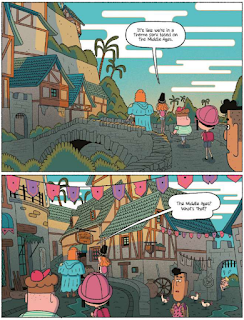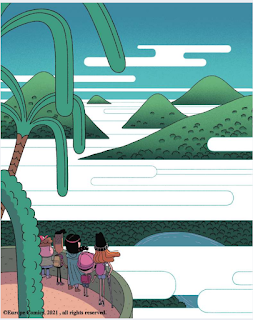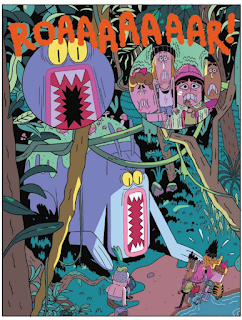Rating: 4.5/5
Synopsis: After a class group of five kids fall into a pit, they subsequently find themselves in the future and embark on a journey back home.
My Thoughts: Plot (5/5) – Most futuristic stories tend to take the following approaches to envisioning their setting:
1. A utopian future (think The Jetsons) where the state of affairs and life is perfect for the most part has just about anything one can fathom.
2. Its dystopian opposite rife with corruption, technology gone haywire, and a general sense of bleakness (most cyberpunk narratives).
3. Post-apocalypse where the remnants of civilization are thriving in a cruel survival game within a barren landscape (Mad Max)
4. A delicate balance between the former two (Futurama).
Not to say any of these aforementioned narrative options are objectively good or bad, but I loved how Lost in the Future said nuts to any of these and decided to paint a society that feels like a regression from what’s considered a modern society where the technological advancement hasn’t seemed to evolve past the medieval era. This ends up creating more mystery surrounding the formation of this civilization whose inhabitants are hinted at being aliens who settled on Earth after human societies were either abandoned or destroyed. After all, they would need to possess some form of technology (or magic if the series ever venture in the fantasy direction) to be able to find this planet.
Characters (3.8/5) – Due to the volume’s length, some of the main cast’s personalities are not fully developed, but they are given enough characterization to be distinctive, particularly Piero, the assertive bully who started the entire conflict, and Mei, the resourceful, sharp-witted one of the crew. Moreover, the villagers were pretty amusing including the mildly whimsical but helpful and caring knight-like character Antoine.
Art (5/5) – This is easily the most unique part of the book. The character designs came in a variety of shapes and sizes that, to an extent, reminded me of Cartoon Network shows such as Clarence and the 2d portions of The Amazing World of Gumball. The lineart followed a curvy, clean, and thin aesthetic that felt visually pleasant and a bit surreal with what I can best describe as zig-zagged arches during the scenic scenes. Furthermore, there were some nice examples of silhouettes, lighting, and shades which, in combination with the occasionally unconventional panel composition, heightened the various moods conveyed.
Pacing (4/5) – It was mostly fast-paced in a positive way that made the story progress smoothly, leaving me invested in what comes next. However, I thought the beginning could have been improved if opened a few pages before the end of the school field trip and gave the kids a little more background. Perhaps bits of their lives will be unraveled in coming installments though, so I wouldn’t consider this a major offender.
Final Thoughts: Lost in the Future: The Storm had me looking forward to this series’ future. I would recommend it to middle-graders and older who enjoy quick-paced sci-fi/fantasy with kid ensemble casts.
Thanks to Europe Comics and NetGalley for providing me with my first advance ebook copy in exchange for an honest review.




No comments:
Post a Comment
Remember to be respectful of each other's opinions. Any hateful or defamatory comments will be removed.